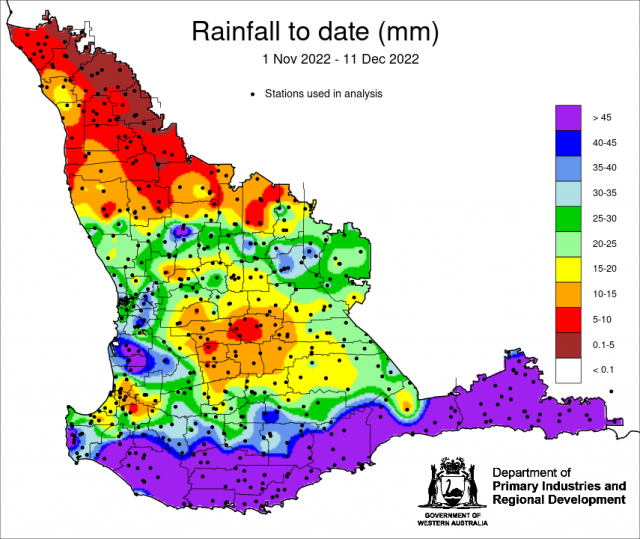Recent climate
November rainfall was above average along the south coast and Central Wheatbelt with reports of hail and fires after a series of thunderstorms. November maximum temperatures were below average to very much below average. Minimum temperatures were below average to average. Rainfall to date map for 1 November to 11 December 2022 shows heavy rainfall along the south coast.
In November the atmospheric pressure was near normal over the SWLD.
Sea surface temperatures have remained warmer than average around much of the Australian coastline, particularly to the north and west. The sea surface temperature outlook for December to February by the Bureau of Meteorology indicates SSTs will cool to the north of Western Australia due to Indian Ocean Dipole decaying. SSTs are likely to remain warmer off the south west coast. Warmer temperatures marginally increase the likelihood of tropical cyclones developing.
The Indian Ocean Dipole (IOD) has returned to neutral.
The Southern Annular Mode (SAM), also known as the Antarctic Oscillation (AAO), describes the north–south movement of the westerly wind belt that circles Antarctica, dominating the middle to higher latitudes of the southern hemisphere. SAM is currently positive and is likely to remain positive throughout December. The Southern Annular Mode (SAM) is in a weakly positive phase and is likely to be neutral to positive through December. During summer, a positive SAM increases the chance of above average rainfall for parts of eastern Australia and below average rainfall for western Tasmania. SAM has no influence on rainfall in the SWLD in summer. For more information see the Bureau of Meteorology’s Climate Driver Update.
La Niña continues in the tropical Pacific. Atmospheric and oceanic indicators of the El Niño–Southern Oscillation (ENSO) reflect a mature La Niña. Models suggest a return to ENSO-neutral in January or February 2023. La Niña increases the chance of above average rainfall for northern and eastern Australia during spring and summer, and the number of tropical cyclones during a La Niña is generally higher than average.
The table below gives a summary of past month and three-month South West Land Division (SWLD) climate conditions, and can indicate what is likely to occur in the near future if climate conditions follow the current pattern.
| Climate Indicator | Past month | Past 3 months |
|---|---|---|
| SWLD Rainfall | Average to above average | Mixed |
| SWLD Mean Temperature | Below average to very much below average | Below average to very much below average |
| SWLD atmospheric pressure | Normal | Higher |
| Indian Ocean Sea surface temperature | Warmer | Warmer |
| El Niño/Southern Oscillation (ENSO) | La Niña | La Niña |
| Indian Ocean Dipole (IOD) | Neutral | Negative |
| Southern Annular Mode (SAM) | Positive | Positive |

